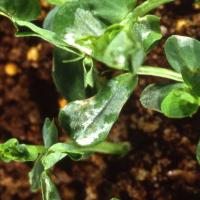Diagnosing mite damage in field peas
Field peas are very susceptible to mite damage at the seedling stage. As peas are generally sown after other crops, earthmites, redlegged earth mite (RLEM) and blue oat mite (BOM), are generally in low numbers. However, even low numbers of mites can damage pea crops
What to look for
- Adult redlegged earth mites are 1 mm long with a black body and eight red-orange legs. Newly hatched mites are 0.2 mm long with a pinkish-orange body and 6 legs.
- Adult blue oat mites are 1 mm long with eight red-orange legs. The body is dark purplish-blue with a red spot on the back.
Insect Adult
- Heavy infestations can kill seedlings as they emerge.
- Leaves are bleached and distorted, with mites clustered inside unfolding leaves.
Plant
Where did it come from?

Alternate host
- RLEM comes from South Africa, and usually have 3 generations per season. In spring females of the last generation die with thick walled oversummering eggs inside them.
- Oversummering eggs hatch in autumn, stimulated by adequate moisture and at least 7 days of temperatures below 20°C.
- Mite damage tends to be worse after pastures than cereal crops.
- Mite damage is common in early sown crops in years with summer rain and green bridge.
Management strategies

Spraying insecticide


Grass weed control

Rotation
- Spray only if you need to.
- RLEM have been detected that have resistance to synthetic pyrethroids and omethoate. Rotate chemical groups in and between seasons, as this will help to reduce resistance occurring.
- Use insecticide seed treatments on pea seeds that are to be planted into paddocks with moderate pest pressure rather than spraying whole paddocks. This allows for smaller quantities of pesticide to be used that will directly target plant feeding such as mites and aphids.
- Set-up paddocks the year before planting peas, control weeds in the crop and along fencelines that provide habitat for mites.
- Look at your cropping rotations to decrease reliance on pesticides. The risk is generally highest if paddocks have been in long term pasture (with high levels of broad-leafed plants) where mite populations have been uncontrolled. Lower risk paddocks that generally do not require mite control are often those which follow a weed free cereal or chickpea crop.
How can it be monitored?
- Check paddock for mites in the spring and again before seeding. Check for mites on the ground and leaves and for plant damage from emergence to early vegetative stage, particularly in late sown crops.
See also
Further information
Page last updated: Wednesday, 13 May 2015 - 2:14pm



